Key takeaways:
- Selective mutism is an anxiety disorder that hinders children’s ability to speak in social situations, impacting their self-esteem and social interactions.
- Effective strategies for presentations include practicing in front of a mirror, using visual aids, and rehearsing with supportive peers to build confidence.
- Managing anxiety can be achieved through deep breathing, preparation with bullet points, and positive self-talk to shift perspective and encourage calmness.
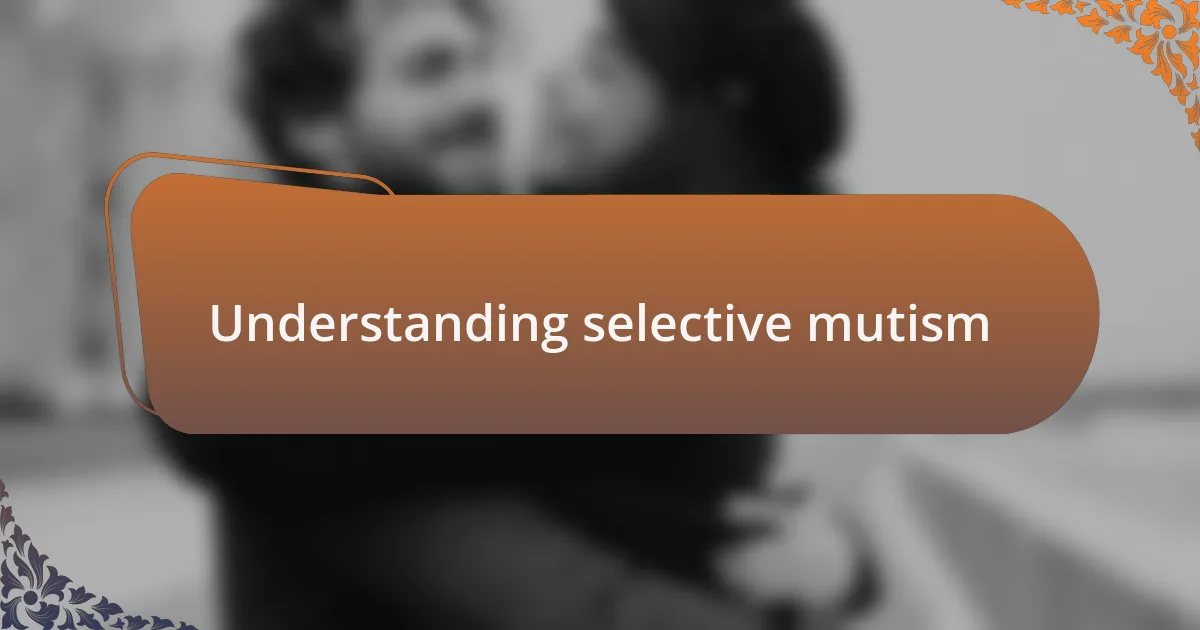
Understanding selective mutism
Selective mutism is a complex anxiety disorder that typically affects children, causing them to be unable to speak in certain social situations, even though they can communicate comfortably in environments where they feel secure. I remember my own experience; in classroom settings, my heart would race, and my voice would feel trapped, leaving me mute while my hands trembled. Have you ever felt the pressure of eyes on you, completely freezing your ability to express yourself?
Understanding selective mutism also involves recognizing the feelings of isolation and frustration that often accompany it. I used to feel a wave of sadness wash over me when classmates would engage in discussions, knowing I had so much to contribute yet couldn’t find the words. It’s disheartening to want to participate but feel like there’s an invisible barrier holding you back, isn’t it?
Many parents and teachers may not realize that selective mutism doesn’t reflect a child’s intelligence or willingness to speak; it’s often rooted in deeper anxiety. I’ve seen friends struggle in silence, and it’s a tough pill to swallow, knowing they want to share their thoughts but simply can’t. How do we create a supportive environment for these children to flourish when their voices are stifled?

The impact of selective mutism
The impact of selective mutism can be profound, often leading to significant challenges in social interactions and academic performance. I recall feeling an immense weight on my chest during group activities, where my silence might have been misinterpreted as disinterest. Have you ever been in a situation where you desperately wanted to jump into a conversation but felt invisible instead?
Beyond the classroom, the effects extend into friendships and family dynamics. There were numerous instances when I avoided playdates or gatherings out of sheer fear, leaving my friends pondering why I ghosted them without explanation. This sense of alienation can chip away at self-esteem, creating a cycle of avoidance that’s tough to break.
Moreover, the long-term repercussions of selective mutism can affect a child’s identity and personal growth. I’ve seen how the struggle to be heard can lead to a heavy burden of anxiety later in life. How can we help shift this narrative and empower individuals to find their voice amidst the struggle?
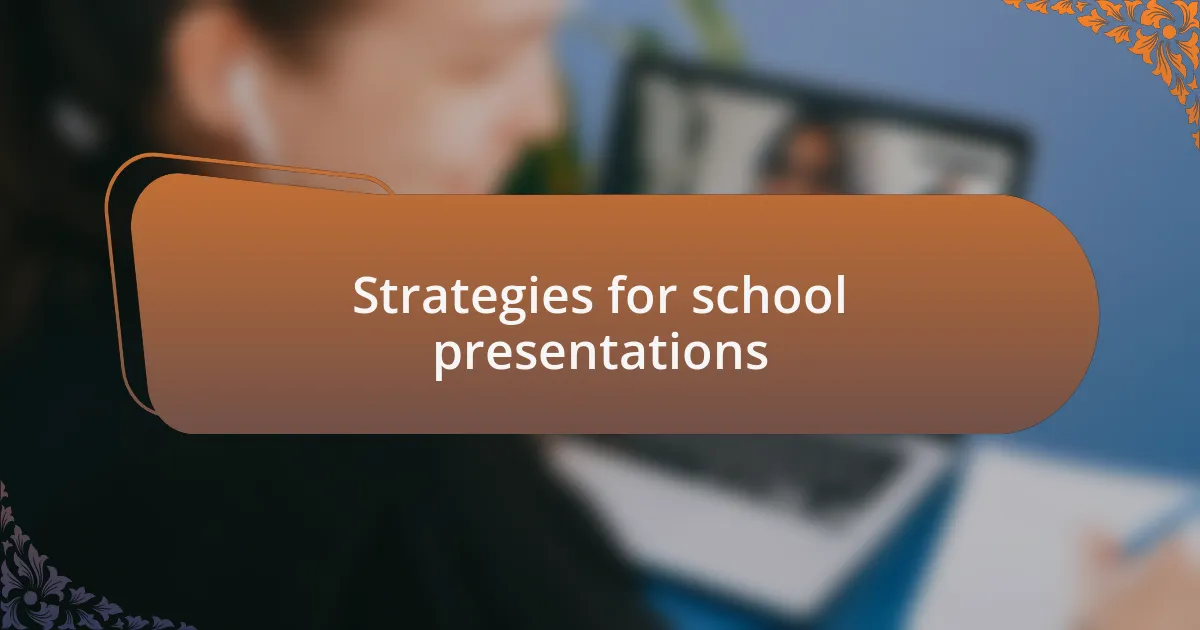
Strategies for school presentations
When it comes to preparing for school presentations, one effective strategy is to practice in front of a mirror or record yourself. I remember feeling more comfortable when I could watch my own expressions and body language. Isn’t it fascinating how seeing yourself can boost your confidence? This small act made a huge difference; it allowed me to tweak my delivery before stepping into the spotlight.
Another technique that worked wonders for me was utilizing visual aids. Incorporating slides or props helped me feel less pressure to speak continuously. When I showcased a powerful image or a simple chart, it not only engaged my classmates but also provided me with a visual anchor to guide my speech. I’ve discovered that giving myself these cues can alleviate some of the anxiety that comes with public speaking.
Lastly, rehearsing with a friend or trusted teacher created a safe space for feedback. I vividly recall one practice session where my friend cheered me on, making the process feel less intimidating. Have you ever shared your fears with someone who truly listened? It not only made me more relaxed but also built a support system that I could rely on during the actual presentation.
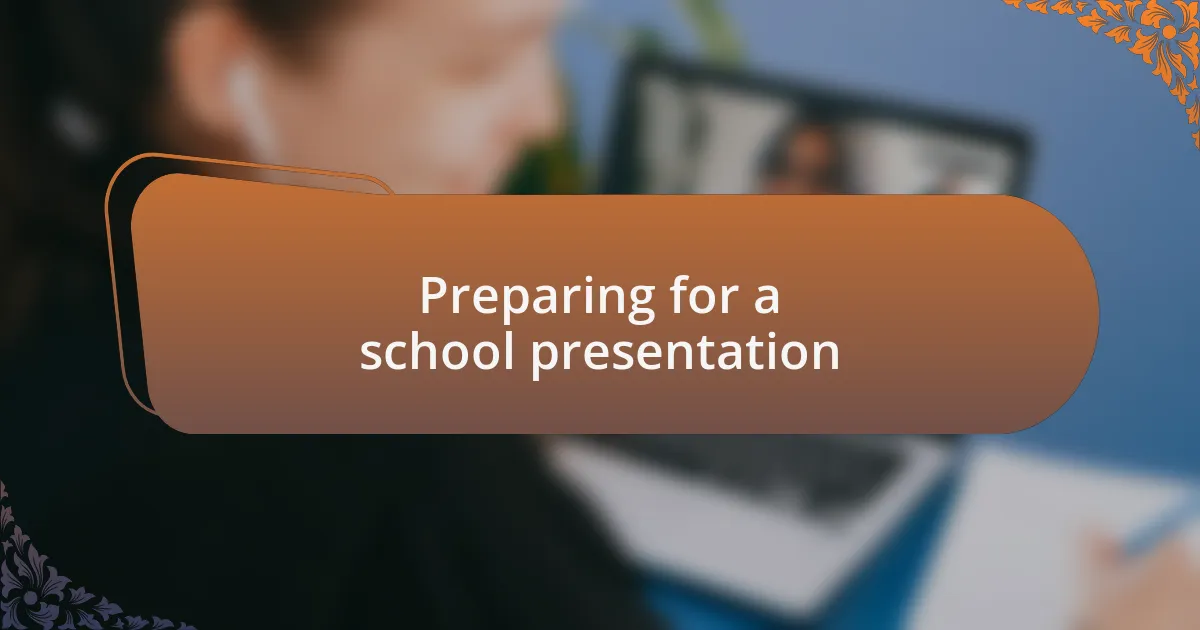
Preparing for a school presentation
Before stepping into the spotlight, I always found it beneficial to write a script or an outline for my presentation. I recall a time when I jotted down bullet points that highlighted the key messages I wanted to convey. Have you ever felt lost in your thoughts while speaking? Having that written guide not only organized my ideas but also gave me a reassuring roadmap that I could glance at to stay on track.
Another essential part of my preparation involved visualizing success. I vividly remember sitting quietly before my presentations, picturing myself confidently delivering my speech and receiving applause from my peers. Isn’t it amazing how our minds can shape our realities? This mental rehearsal helped me transition from feelings of dread to a sense of excitement, making me more eager to share my knowledge with others.
Lastly, I discovered the power of familiarizing myself with the presentation environment. I made it a point to visit the room beforehand and even practice my delivery there. Do you think it makes a difference to feel at home in the space where you will present? I found that knowing the layout and where I could stand made me feel much more grounded and ready to face my audience when the moment finally arrived.
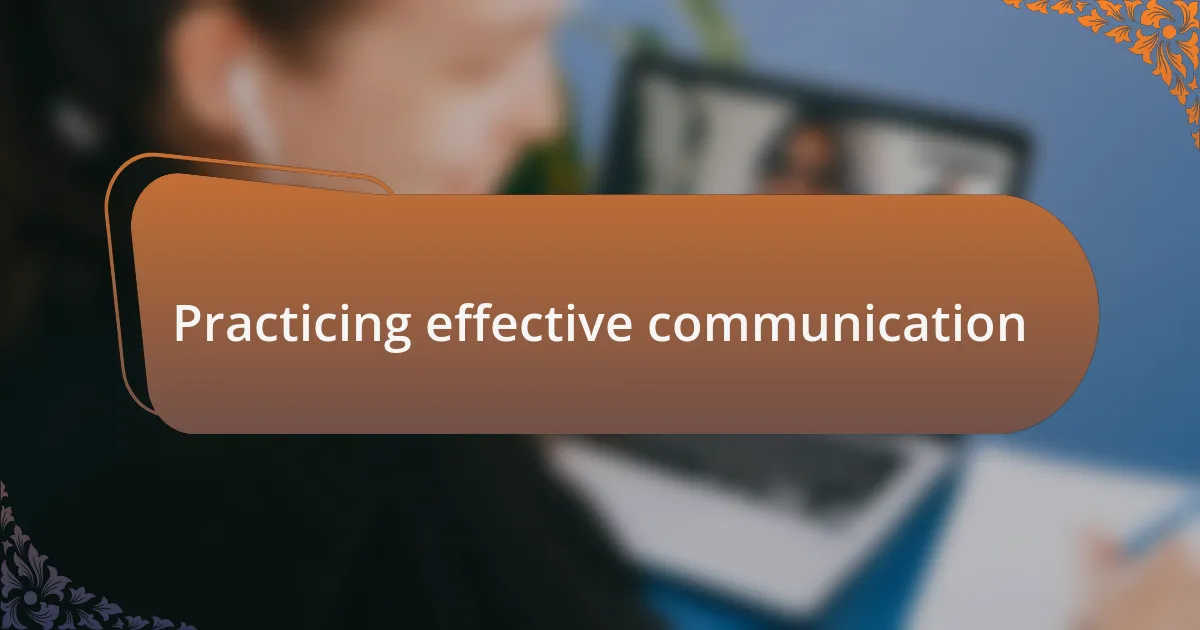
Practicing effective communication
Practicing effective communication became a game-changer for me during school presentations. I remember one instance where I struggled to express my ideas clearly until I started engaging in role-playing exercises with friends. Have you ever tried bouncing ideas off someone else? It not only helped refine my message but also alleviated the anxiety of speaking in front of a larger audience.
I also realized that tone and body language play crucial roles in how we communicate. There’s a moment I’ll never forget when I delivered a presentation with a monotone voice, and the energy in the room felt flat. Reflecting on that experience, I learned to vary my pitch and incorporate gestures, which truly transformed my delivery. Isn’t it incredible how small adjustments can make such a significant impact?
Another strategy I leaned on was the practice of active listening. In group discussions, I focused intently on my classmates’ reactions and feedback. I found that when I genuinely listened, it not only improved my responsiveness but also built a connection with my audience. Don’t you think that establishing that connection is vital for effective communication? Being attuned to others’ responses made my presentations feel more like conversations rather than monologues.
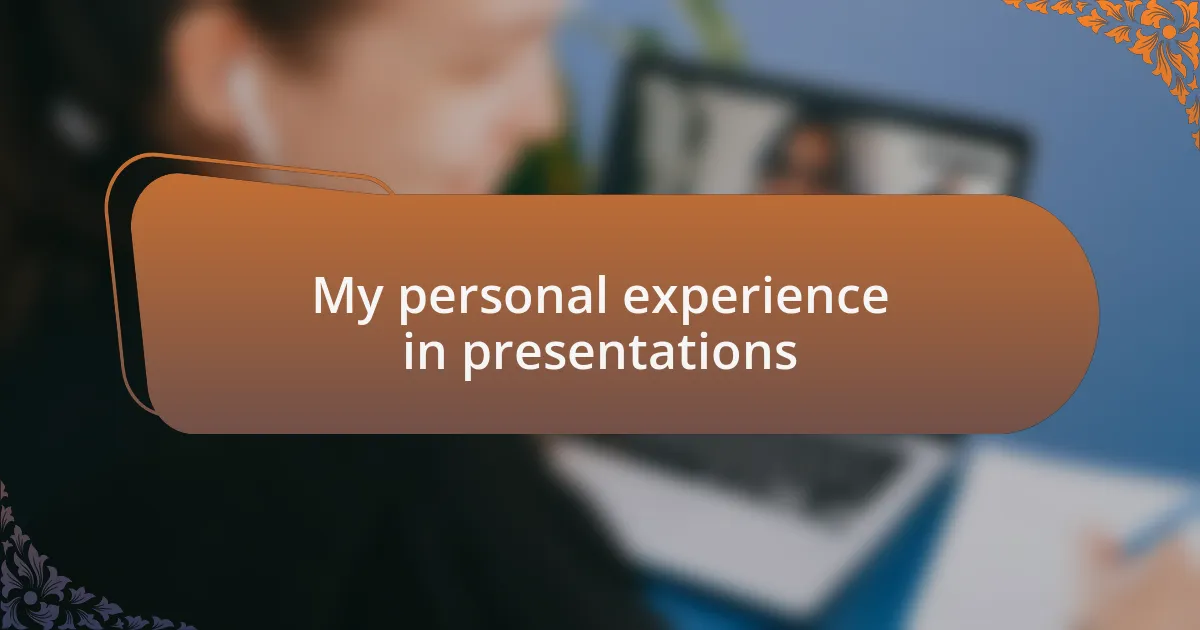
My personal experience in presentations
My experience with presentations often felt like walking a tightrope. I vividly recall the day of my first major presentation; my hands were clammy, and my heart raced as I stood in front of the class. That overwhelming fear of being judged had me stuttering over my words. Have you ever felt that way? It took every ounce of courage just to get through the first few sentences, yet I discovered that vulnerability can actually draw people in, making my struggle relatable.
There was also that time I tried visual aids for the first time. I had created a colorful poster that illustrated my points, and to my surprise, it captivated my classmates. Watching their eyes light up as they engaged with my visuals was an emotional turning point for me. What was once a source of stress turned into an opportunity for connection. It made me wonder how often we underestimate the tools at our disposal; sometimes, visuals can speak when our words fail us.
Looking back, I realize how much I grew through these experiences. Each presentation was a step toward confidence, despite the challenges I faced. I remember celebrating the small wins—like when a classmate complimented my improvement. Isn’t it fascinating how recognition from others can bolster our self-esteem? Those moments fueled my determination to keep pushing through my fears and ultimately find my voice.
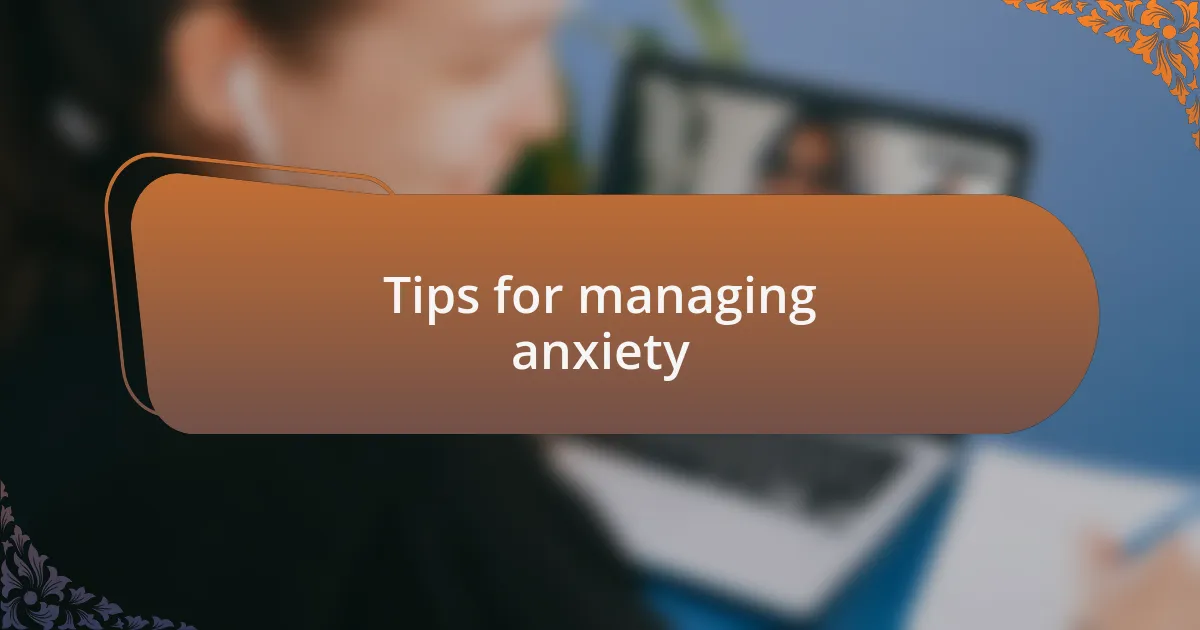
Tips for managing anxiety
When anxiety looms before a presentation, I’ve found that deep breathing exercises can work wonders. I would often take a moment away from the crowd to inhale deeply, hold it for a few seconds, and then exhale slowly. This simple technique not only calmed my nerves but also gave me a moment to refocus my thoughts. Have you ever tried it? It’s amazing how just a few breaths can help regain control over those racing thoughts.
Another strategy that helped me significantly was preparation. I remember a particularly challenging presentation where the material felt overwhelming. Rather than memorizing my lines verbatim, I created a bullet list of key points. This approach allowed me to speak more naturally, easing the pressure to perform perfectly. Have you experienced the relief that comes from feeling prepared? It’s like giving yourself a safety net, allowing for a smoother presentation experience.
Finally, I discovered the power of positive self-talk. On days when self-doubt crept in, I made it a habit to remind myself of past successes. Reflecting on moments—like when I received applause for a job well done—fueled my motivation. It’s curious how shifting our internal dialogue can change our perspective. Have you noticed how a few encouraging words to yourself can shift your mood? It’s a small but influential way to combat anxiety and build confidence in public speaking.